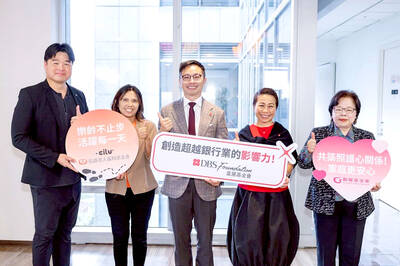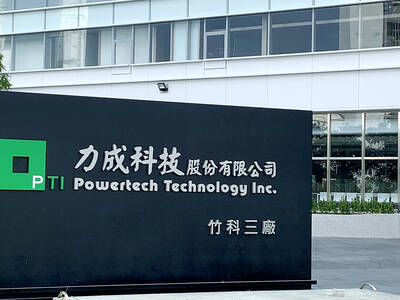Bank Rakyat Indonesia (BRI), one of Indonesia’s largest state-owned banks, yesterday opened its doors to customers after launching its first branch in Taiwan, which is home to a large Indonesian community.
The Taipei branch — the first opened in Taiwan by any Indonesian state-owned bank — would initially target Indonesian nationals in Taiwan and businesses with ties to Indonesia, branch business manager M. Baiquni Husein said.
The branch, which is in downtown Taipei, would first focus on encouraging Indonesian migrant workers to open savings accounts, especially because 60 to 70 percent of them have BRI accounts in Indonesia, Baiquini said.
However, Indonesians hoping to use the bank to make overseas remittances would have to wait a little longer, Baiquini said.
The bank said it is in the final stages of getting approval for the service, and should be able to offer foreign remittances next year.
Remittances could eventually be a main driver of the branch’s revenue.
Taiwan was home to 240,628 Indonesian migrant workers as of the end of October, branch general manager Endry Supriadi said, adding that they send about 7 trillion to 8 trillion rupiah (US$487.88 million to US$557.58 million) home per year.
However, in promoting remittances, the bank would be challenged to offer competitive fees.
Indonesian workers said they often use Indonesian stores to send money home or go through friends who have access to remittance applications, and the fee is relatively low, ranging from NT$100 to NT$200 per transfer.
Baiquni said the bank expects to be competitive in this area, and would offer faster money transfers by keeping the end-to-end remittance chain within the bank’s network, rather than having to rely on other banks.
Although the sizable migrant worker population is expected to be a solid customer base for the branch, Endry said that it also hopes to act as a bridge for Indonesian expatriates or Taiwanese for investment-related services.
After obtaining permission from Taiwan’s central bank, BRI hopes to offer foreign-currency deposit accounts, issue letters of credit and open investment opportunities for Taiwanese in Indonesia, he said.
“We have seen the flow of investment from Taiwan to Indonesia increase, and some big companies from Taiwan are interested in establishing factories in Indonesia,” Endry said.
Established on Dec. 16, 1895, in Purwokerto, Central Java Province, BRI focuses on micro, small and medium-sized enterprises, and has thousands of outlets and branches across Indonesia.
The Taipei branch is just its third overseas branch in East and Southeast Asia, following branches in Singapore and Timor-Leste, said Norman Lubis, the Taipei branch’s public relations manager.

RUN IT BACK: A succesful first project working with hyperscalers to design chips encouraged MediaTek to start a second project, aiming to hit stride in 2028 MediaTek Inc (聯發科), the world’s biggest smartphone chip supplier, yesterday said it is engaging a second hyperscaler to help design artificial intelligence (AI) accelerators used in data centers following a similar project expected to generate revenue streams soon. The first AI accelerator project is to bring in US$1 billion revenue next year and several billion US dollars more in 2027, MediaTek chief executive officer Rick Tsai (蔡力行) told a virtual investor conference yesterday. The second AI accelerator project is expected to contribute to revenue beginning in 2028, Tsai said. MediaTek yesterday raised its revenue forecast for the global AI accelerator used

Taiwan Semiconductor Manufacturing Co (TSMC, 台積電) has secured three construction permits for its plan to build a state-of-the-art A14 wafer fab in Taichung, and is likely to start construction soon, the Central Taiwan Science Park Bureau said yesterday. Speaking with CNA, Wang Chun-chieh (王俊傑), deputy director general of the science park bureau, said the world’s largest contract chipmaker has received three construction permits — one to build a fab to roll out sophisticated chips, another to build a central utility plant to provide water and electricity for the facility and the other to build three office buildings. With the three permits, TSMC

The DBS Foundation yesterday announced the launch of two flagship programs, “Silver Motion” and “Happier Caregiver, Healthier Seniors,” in partnership with CCILU Ltd, Hondao Senior Citizens’ Welfare Foundation and the Garden of Hope Foundation to help Taiwan face the challenges of a rapidly aging population. The foundation said it would invest S$4.91 million (US$3.8 million) over three years to foster inclusion and resilience in an aging society. “Aging may bring challenges, but it also brings opportunities. With many Asian markets rapidly becoming super-aged, the DBS Foundation is working with a regional ecosystem of like-minded partners across the private, public and people sectors

BREAKTHROUGH TECH: Powertech expects its fan-out PLP system to become mainstream, saying it can offer three-times greater production throughput Chip packaging service provider Powertech Technology Inc (力成科技) plans to more than double its capital expenditures next year to more than NT$40 billion (US$1.31 billion) as demand for its new panel-level packaging (PLP) technology, primarily used in chips for artificial intelligence (AI) applications, has greatly exceeded what it can supply. A significant portion of the budget, about US$1 billion, would be earmarked for fan-out PLP technology, Powertech told investors yesterday. Its heavy investment in fan-out PLP technology over the past 10 years is expected to bear fruit in 2027 after the technology enters volume production, it said, adding that the tech would